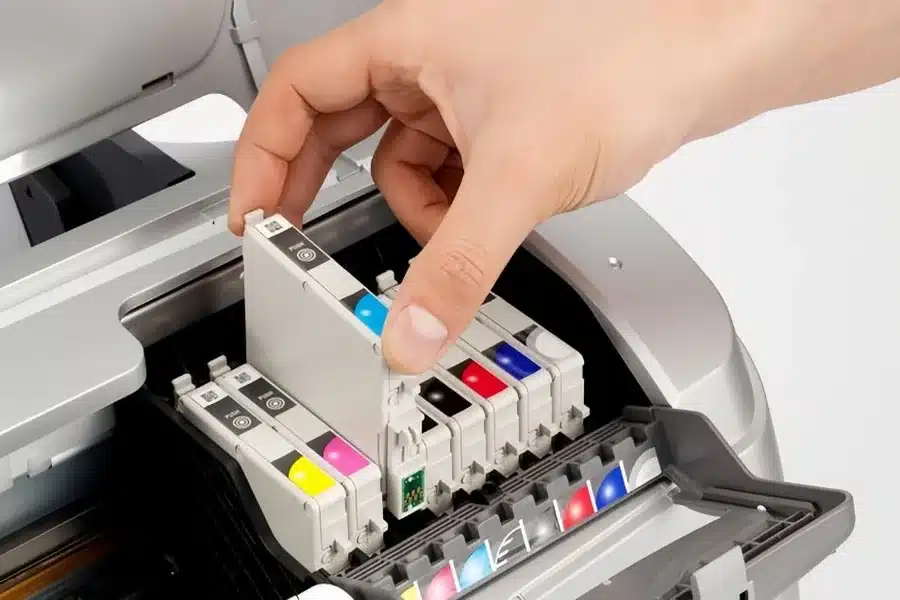How to Choose the Right Ink Cartridge for Your Printer

There’s nothing quite like the moment you hit “print” on an important document, only to have your printer throw up an error message because it’s low on ink
At first glance, buying printer ink seems straightforward. But once you’re standing in front of a shelf full of nearly identical-looking cartridges (or scrolling through page after page of product listings online), it becomes clear that there’s more to this than meets the eye.
If you’ve ever felt confused about ink cartridges, you’re not alone. In this guide, we’ll break down how to choose the right printer ink. Please note, this guide is specifically for ink cartridges (not ink bottles or toner cartridges) and is here to help you choose the right one so you can avoid wasting time, money, or paper.
1. Identify Your Printer Model
Before you proceed with buying printer ink, take note of your printer’s model. It’s usually printed clearly on the front of the device or listed inside the cartridge access panel. Something like “Canon PIXMA TS5160” or “Brother MFC-J491DW.”
This model number is the key to everything. Why? Because different printers, even within the same brand, use completely different cartridges. Buying the wrong one might mean it physically doesn’t fit, or it’s incompatible.
2. Understand What “Compatible” Really Means
You’ll often see printer ink cartridges categorized as OEM, compatible, or remanufactured. Here’s how they differ:
- OEM (Original Equipment Manufacturer): These printer ink cartridges are made by the same company that made your printer, like HP, Epson, Canon, or Brother. OEM ink is typically the most reliable, but it’s also the most expensive.
- Compatible: These printer ink cartridges are made by third-party manufacturers to work with your printer. Good ones offer quality close to OEM at a much lower cost, but quality varies between brands.
- Remanufactured: These are recycled OEM cartridges that have been cleaned, refilled with fresh printer ink, and tested for quality. A more sustainable and often cost-effective option.
While OEM printer ink cartridges are the safest bet, many high-quality third-party or remanufactured cartridges perform just as well. If you’re shopping around, make sure you choose a reputable supplier and read user reviews specific to your printer model.
3. Check for Ink Series Numbers, Not Just Brand Names
Let’s say you own an HP printer. That doesn’t mean any HP cartridge will work in it. Every printer line uses a specific ink series: HP 61, HP 67XL, HP 952, and so on.
Using the wrong series, even within the same brand, can cause error messages or won’t be recognized at all. Always double-check the ink code listed on your existing cartridge or your printer’s manual before buying new ones.
4. Decide Between Standard and High-Yield (XL)
When shopping for printer ink, you’ll likely see two versions of the same cartridge: standard and XL.
- Standard cartridges contain less ink and are ideal for occasional printing.
- XL cartridges hold more ink, cost a bit more up front, but offer a much lower cost per page.
For example, if you print a few pages a week, standard ink may be all you need. But if you’re running through cartridges every month, XL is a smarter long-term choice.
One thing to note: XL cartridges are usually the same size as standard ones, they just hold more ink internally.
5. Watch Out for Firmware Updates
This one surprises a lot of people: some printers use firmware updates to block third-party cartridges. An update might render your previously working compatible ink suddenly unusable.
If you prefer using remanufactured or compatible printer ink, check whether your printer allows you to disable automatic updates. Alternatively, stick with suppliers who keep their cartridges updated for the latest firmware versions.
6. Take Note of Your Printing Habits
Your ink cartridge needs depend a lot on what and how often you print. For example:
- Occasional users may prioritize standard cartridges to avoid ink drying out over time.
- Frequent users will save more with XL or multipacks.
- Photo printers should consider specialized color ink sets for enhanced depth and accuracy.
- Office users might need bulk-buy options or ink subscription services.
Being aware of your print habits helps you avoid overbuying or running out at the worst moment.
7. Storage and Expiration
Many people don’t realize that printer ink has a shelf life. Ink cartridges typically last up to two years unopened, but once opened, they’re best used within six months to maintain quality.
If you print infrequently, resist the urge to stockpile ink unless you know you’ll use it before it expires. Also, store ink cartridges in a cool, dry place away from heat and sunlight.
8. Review Return Policies Before Purchasing
Ink cartridges are one of those purchases where mistakes happen, even with the best intentions. Whether you accidentally buy the wrong series or your printer refuses to accept a compatible cartridge, a flexible return policy can save the day.
9. Choose a Trusted Supplier
The quality of the ink you use directly affects your printer’s performance and your results. It’s tempting to buy the cheapest printer ink you can find online, but low-quality ink can lead to clogs, poor print quality, and even damage your printer.
Buy from sellers who specialize in ink and printer supplies. Look for detailed product descriptions, verified reviews, and clear compatibility listings. Whether you prefer OEM cartridges or want to save with reliable alternatives, a good supplier will offer both.
Final Thoughts
Choosing the right printer ink cartridge isn’t just about compatibility, it’s about balancing quality, efficiency, cost, and reliability. From knowing your printer model and ink series to weighing the pros and cons of OEM vs. remanufactured, a bit of research up front can prevent a lot of inconvenience later on.








